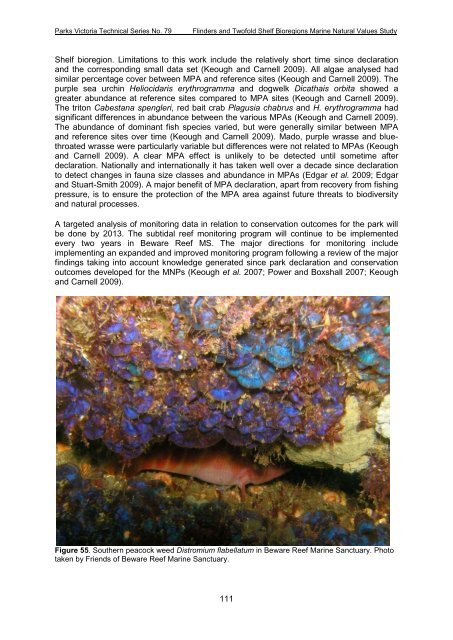parks victoria technical series marine natural values study vol 2 ...
parks victoria technical series marine natural values study vol 2 ...
parks victoria technical series marine natural values study vol 2 ...
You also want an ePaper? Increase the reach of your titles
YUMPU automatically turns print PDFs into web optimized ePapers that Google loves.
Parks Victoria Technical Series No. 79<br />
Flinders and Twofold Shelf Bioregions Marine Natural Values Study<br />
Shelf bioregion. Limitations to this work include the relatively short time since declaration<br />
and the corresponding small data set (Keough and Carnell 2009). All algae analysed had<br />
similar percentage cover between MPA and reference sites (Keough and Carnell 2009). The<br />
purple sea urchin Heliocidaris erythrogramma and dogwelk Dicathais orbita showed a<br />
greater abundance at reference sites compared to MPA sites (Keough and Carnell 2009).<br />
The triton Cabestana spengleri, red bait crab Plagusia chabrus and H. erythrogramma had<br />
significant differences in abundance between the various MPAs (Keough and Carnell 2009).<br />
The abundance of dominant fish species varied, but were generally similar between MPA<br />
and reference sites over time (Keough and Carnell 2009). Mado, purple wrasse and bluethroated<br />
wrasse were particularly variable but differences were not related to MPAs (Keough<br />
and Carnell 2009). A clear MPA effect is unlikely to be detected until sometime after<br />
declaration. Nationally and internationally it has taken well over a decade since declaration<br />
to detect changes in fauna size classes and abundance in MPAs (Edgar et al. 2009; Edgar<br />
and Stuart-Smith 2009). A major benefit of MPA declaration, apart from recovery from fishing<br />
pressure, is to ensure the protection of the MPA area against future threats to biodiversity<br />
and <strong>natural</strong> processes.<br />
A targeted analysis of monitoring data in relation to conservation outcomes for the park will<br />
be done by 2013. The subtidal reef monitoring program will continue to be implemented<br />
every two years in Beware Reef MS. The major directions for monitoring include<br />
implementing an expanded and improved monitoring program following a review of the major<br />
findings taking into account knowledge generated since park declaration and conservation<br />
outcomes developed for the MNPs (Keough et al. 2007; Power and Boxshall 2007; Keough<br />
and Carnell 2009).<br />
Figure 55. Southern peacock weed Distromium flabellatum in Beware Reef Marine Sanctuary. Photo<br />
taken by Friends of Beware Reef Marine Sanctuary.<br />
111

















